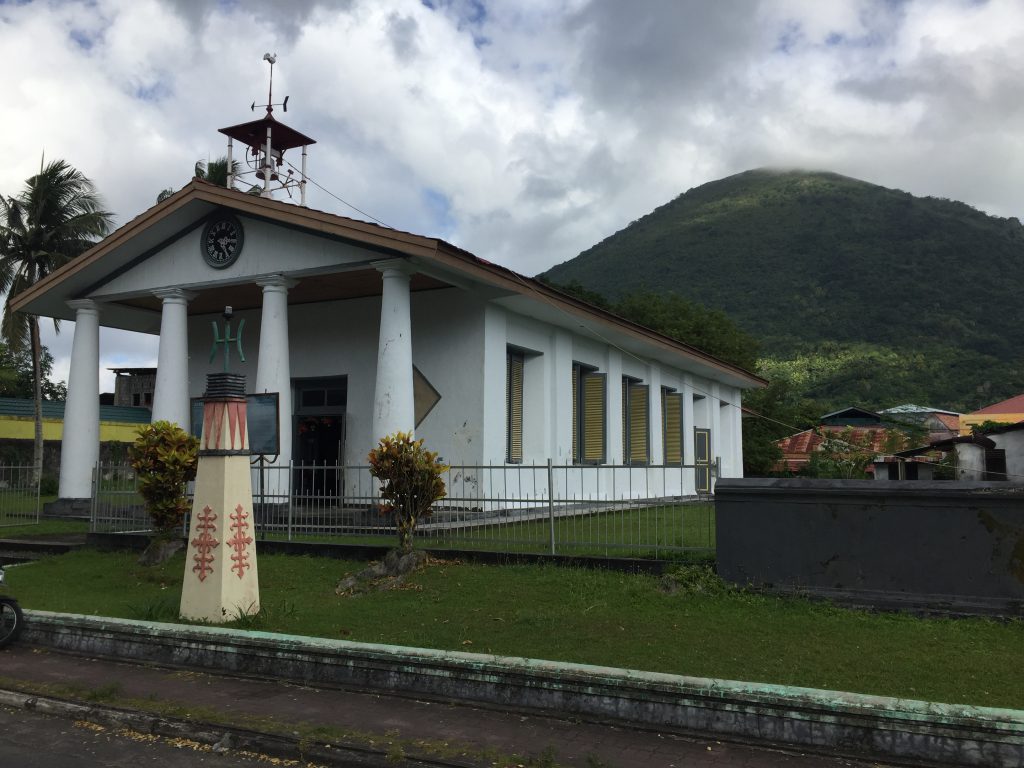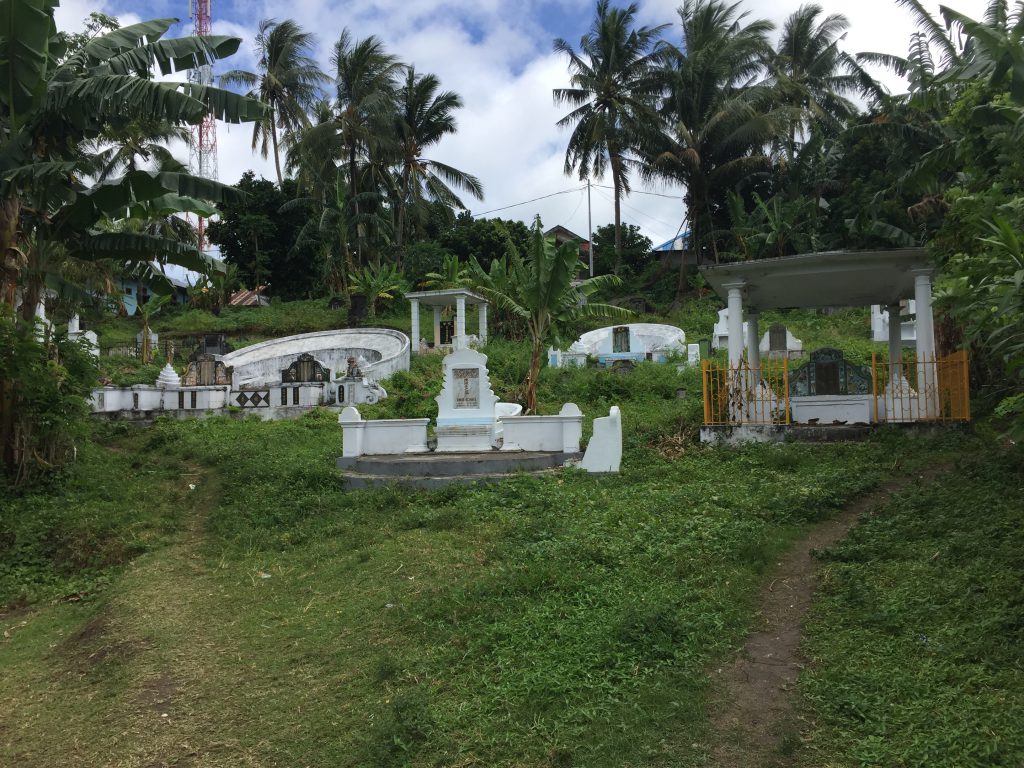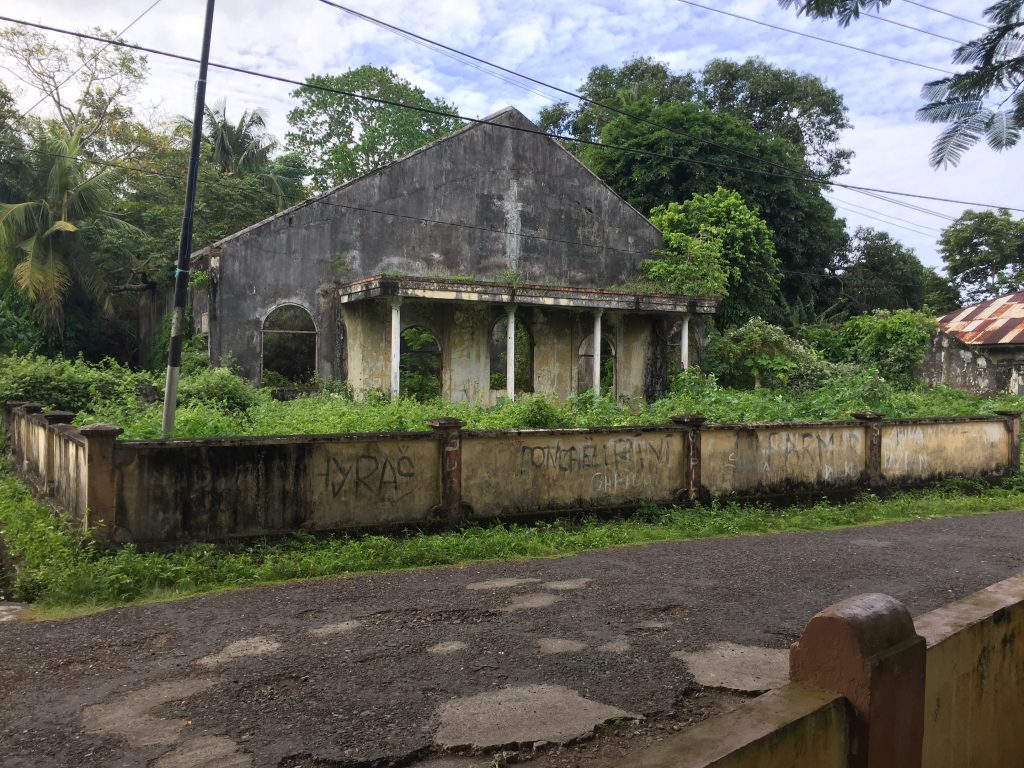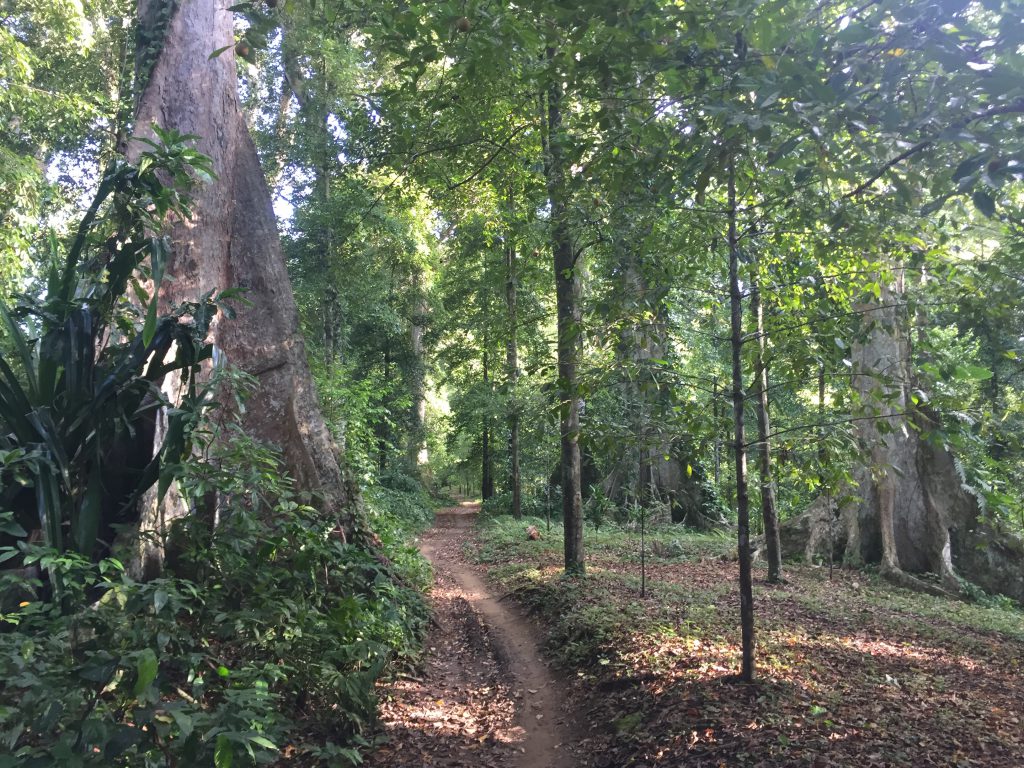Nutmeg farms are stunningly beautiful. The smell of cinnamon, cloves, pepper and nutmeg fill the air.
 In Somerset Maugham’s 1932 novel, The Narrow Corner, three worldly travelers, all practical-minded criminals of a sort, dock at the remote Dutch colonial island of Banda Neira, called Kanda Meira in the book, during a journey through the Spice Islands of the Banda Sea. They encounter two naïve tropical island dropouts from Europe, Erik and Firth, who seem to be living in dream-worlds of their own making. A collision of world-views occurs, leading one of the characters to his death.
In Somerset Maugham’s 1932 novel, The Narrow Corner, three worldly travelers, all practical-minded criminals of a sort, dock at the remote Dutch colonial island of Banda Neira, called Kanda Meira in the book, during a journey through the Spice Islands of the Banda Sea. They encounter two naïve tropical island dropouts from Europe, Erik and Firth, who seem to be living in dream-worlds of their own making. A collision of world-views occurs, leading one of the characters to his death.

The story’s clash between idealism and practicality is, even today, reflected in Banda Neira’s idyllic setting and fascinating history. The idealism: Here and in other nearby Banda Islands, crystal clear waters, coral reefs and colorful fish make for amazing diving. Beautiful old Dutch colonial houses with wide front porches dot the island. Nutmeg farms are stunningly beautiful. The smell of cinnamon, cloves, pepper and nutmeg fill the air. There are no McDonalds, no Starbucks or other fast food chains. Credit cards are accepted by only one business. The island itself is of such insignificant size, that Apple Maps does not even credit the land-mass with a name.
The local Banda dialect (different from the original Banda language) is a beautiful lilting language, so similar in its intonation to Italian, and to some extent in its pronunciation, that it sounds like, well … Italian. “We hear that all the time,” one Bandanese told me. Speakers seem to use gentle accentuation to soften disagreements or complaints or sometimes to emphasize a point. Below are audio samples of Bandanese making daily conversation on a small boat and playing music and singing by the sea.
The practicality: this beautiful little island and its friendly residents are so distant from the hustle and bustle of the busy outside world, that it is difficult to believe they were significant players in the formation of Western mercantilism and the resulting capitalist economic system.
The Banda Islands are native to nutmeg. During the 17th and 18th centuries, nutmeg, which was highly prized as a meat preservative, a flavoring, and a means to ward off the plague, commanded astonishingly high prices in Europe. But the Banda Islands were half a world away and nutmeg stubbornly refused to grow anywhere else. Europeans had to undertake very risky and expensive business ventures, sailing fleets around the Cape of Good Hope to the East Indies—what is today eastern Indonesia. Often the ships did not return, or came back with empty holds and decimated crews.
Nutmeg and the Dutch East Indies Company
The solution was to distribute the financial risks of the spice trade by establishing the Dutch East Indies Company (VOC) in 1602, which soon thereafter became the first company listed on a publicly traded stock exchange. The VOC eventually became the most valuable company in history. Even today, the Banda Islands still profit handsomely from providing a sizeable fraction of the world’s nutmeg supply. A farmer and his or her family can live comfortably in their own house with the thrice-a-year harvest from 100 nutmeg trees. The islands’ rich volcanic soil and micro-climate probably still produce the best quality nutmeg in the world. But competition is fierce. Starting this year, at least one savvy farmer says he is beginning to use DNA sourcing on his trees to help guarantee the provenance of nutmeg sold in Europe, and perhaps to help prevent the continued sale of diluted nutmeg products on the Chinese market.

The three nutmeg plantations on Banda Neira are no longer productive. But on nearby islands, such as Pulau Ai or Banda Besar, you can find these same plantations in all their splendor, like the one owned by Pongki van den Broeke, a 13th generation nutmeg farmer. He is sometimes called “the last perkenier” (nutmeg farmer). After World War II, his great uncle chose to emigrate to Holland, but his grandfather stayed on the island, and Pongki eventually inherited the 12.5 acre estate with 5000 trees. He says his Dutch cousins often come to visit and have invited him to move to Holland. When I ask him if he likes that idea, he smiles and shakes his head. “My home is a paradise,” he says.
A nutmeg farm is indeed a sight to behold. Towering kanari trees, 50 meters high, provide shade for the nutmeg trees to grow. Perhaps Maugham’s description cannot be improved on: The kanari trees, in the shade of which grew the portly and profitable nutmeg trees, were enormously tall. They towered like the columns of a mosque in the Arabian Nights. Underfoot was no tangle of undergrowth but a carpet of decaying leaves. You heard the boom of great pigeons and saw them flying about with a heavy whirr of wings…. There was an idle sensuousness in the air that was almost material, so that it reminded you of the feel of a soft, rich fabric. The declining sun had found a way under the branches of the lofty kanaris and shown on the foliage of the nutmeg trees so that their dense, opulent green glistened like burnished copper.
Homosexual undertones
The novel’s overt thematic tension between leading a practical life or pursuing a beautiful ideal is also played out in the subtext of the novel. Gore Vidal wrote that The Narrow Corner was Maugham’s “one and only crypto-fag novel.” The main character, Dr. Saunders, is a gay man who served time in the gaol, or jail, and lost his medical license for violating British laws against homosexuality. Contemporary writing about the novel often simply states that Dr. Saunders committed “malpractice,” reflecting the taboo of Maugham’s time. But homosexual undertones are everywhere in the book. Dr. Saunders strikes a tone of cynical but practical resignation when confronted with idealistic young men on the island, who he thinks put too much faith in the virtue of others: The most valuable thing I have learnt from life is to regret nothing. Life is short, nature is hostile, and man is ridiculous. One senses that Saunders’ somewhat jaundiced view of the world is an artifact of his own life’s frustrations. Somerset Maugham himself was a closeted homosexual man with a medical degree.
A walking tour of the island
Today, ships dock at the port on the west side of the island of about 7000 people, but at the time Maugham was writing, ships docked at one of two piers on the south side of the Banda Neira, both of whose earth fill and retaining walls still extend into the sea today. Neither is used except by locals seeking solitude and a cool breeze, or a place for a quiet conversation. Captain Nichols decided not to dock the Fenton at the pier that “belong(ed) to the Netherlands company,” meaning he chose the pier to his left whose exit aligns almost directly with the entrance of what remains of the Dutch fort, and, further up the hill, a well-restored Portuguese fort.

Erik, Dr. Saunders and Fred Blake, another passenger on the Fenton, visited the Portuguese fort around sunset. Today, it opens to the public around 3:30 in the afternoon, which is a good time to visit its high towers, from where one can hear the haunting beauty of the Muslim calls to prayer from several different directions. Across the bay is a volcano island called Banda Api, or Gunung Api, which Fred and Erik hike the next day. It offers beautiful views of the surrounding islands.

From the dock the men turned left and walked into town to find a hotel. Today there are several guest houses and hotels in that area, including one where Princess Diana stayed and left a self-portrait that still hangs on the wall. On their way, they pass Erik’s house, a bungalow with columns supporting an overhanging roof to create a large front porch. There are many such houses in the town in various states of repair; many old Dutch walls that once formed some sort of building are put to use today in one way or another, often as outside walls.
The next day, the three men and Erik visit Firth’s nutmeg plantation three miles away on the other side of the island. Today in that location, there is a small community, many living within the walls of the former compound that would have enclosed Firth’s house and any of his laborer’s living quarters.
When one character dies, a service is held, probably in the recently restored Catholic church.

Lining the floor of the center aisle are stone tablets marking the burial places of prominent Christians who died over the centuries. A 15-minute walk away, there are Christian, Chinese, and Muslim graveyards near a mosque at the top of Merdeka, a large hill. Most Bandanese I spoke with were unaware of the Christian graveyard there, which is overgrown with weeds and grass. The Chinese graveyard has some nice examples of classic style Chinese graves.

Christian/Muslim conflict
All is peaceful now, but in a different part of the island, to the east of the old governor’s house, stands the burnt ruin of another Christian church, a casualty of the Maluku Sectarian Conflict between Christians and Muslims. The conflict began soon after Suharto’s 1998 resignation slowed the economy and disrupted long-standing ways of life between the two communities. In early 1999, a dispute between a Christian minibus driver and a Muslim passenger set off riots on Ambon Island.

By April, problems spread to Banda Neira, where several people were killed, some think as part of a plan by outside forces to create disorder in an attempt to seize power. The entire Christian population of around two-thousand were expelled from the island. Though some have returned since the end of the conflict in 2002, most now live on Ambon Island or the Kai Islands.
Traveling there
A local hotelier puts the number of pre-war annual tourists arriving in Banda Neira at around 5000 and in the present day, around 2000. A large part of the reason the numbers have not fully rebounded has to do with transportation. When the twice-a-week 17-passenger plane arrives from Ambon, the pilot not infrequently circles the airstrip and then, deciding the winds are too strong, heads back to Ambon with all the original passengers still on board. The ditched travelers on the ground have a backup plan. Boats run between Ambon and Banda Neira a couple times per week. My Pelni ferry took 15 hours. Your options for sleep are either spreading out somewhere on the floor of the ferry or renting a cabin-for-two for 700,000 Indonesian rupiahs (about $50 US), if there are any available. There is also a “fast boat” during the high season when more tourists visit the island. This takes about five hours. There is talk of improving the transportation between Banda Neira and the Ambon. It could happen. The United Nations is now considering at least one location on the Banda Islands for inclusion in its list of UNESCO World Heritage Sites.
May the starry-eyed get there before the starry-bucks.
James Weitz—August 2018

